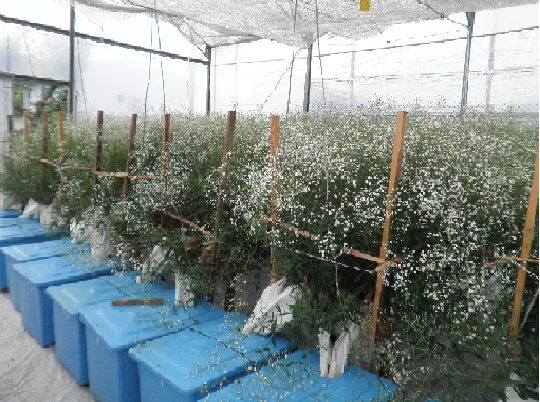Sustratos de cascarilla de arroz y momento de la poda en la producción de gypsophila

Resumen
El objetivo de esta investigación fue evaluar el crecimiento, productividad y calidad de gypsophila variedad New Amore®, cultivada en canales rellenos con sustratos y sistema con recirculación de la solución nutritiva en el sur de Brazil. Los tratamientos fueron el resultado de la combinación de cuatro sustratos [cascarilla de arroz carbonizada (CAC100%), cascarilla de arroz cruda (CACr100%), CAC + sustrato comercial orgánico S10 (Beifort®) (15%) y CACr+ S10 (15%)] y dos épocas de poda (precoz y tardía). Los sustratos no afectaron la distribución de la materia seca entre las flores y los órganos vegetativos, así como el balance entre el crecimiento de la parte aérea y de las raíces. Sin embargo, el cultivo en el sustrato CACr100% redujo el crecimiento de la parte aérea, la producción y la calidad de los tallos florales. Los sustratos CAC100% y CACr+S10 pueden ser indicados para el cultivo de gypsophila debido a los buenos resultados obtenidos. La poda tardía aumentó el crecimiento, la productividad y mejoró la calidad de los tallos florales de gypsophila. Se concluye que las plantas de gypsophila se adaptaron bien al sistema de cultivo con recirculación de la solución nutritiva.
Palabras clave
Tallos florales, productividad, fertirriego, sistemas alternativos de producción, recirculación de la solución
Biografía del autor/a
Daniela Höhn
Doutoranda do Programa de Pós-Graduação em sistemas de Produção Agrícola Familiar - SPAF
Roberta Marins Nogueira Peil
Departamento de Fitotecnia, Universidade Federal de Pelotas, Pelotas - RS (Brasil)
Lais Perin
Doutoranda do Programa de Pós-Graduação em sistemas de Produção Agrícola Familiar - SPAF
Priscila Monalisa Marchi
Doutoranda do Programa de Pós-Graduação em Agronomia - PPGA
Paulo Roberto Grolli
Departamento de Fitotecnia, Universidade Federal de Pelotas, Pelotas - RS (Brasil)
Albertina Radtke Wieth
Mestranda do Programa de Pós-Graduação em Fitotecnia da Universidade Federal de Rio Grande do Sul – UFRGS
Citas
- Andriolo, J.L., D.I. Jänisch, C.S. Oliveira, C. Cocco, O.J. Schmitt, and F.L. Cardoso. 2009. Cultivo sem solo do morangueiro com três métodos de fertirrigação. Ciênc. Rural 39(3), 691-695. Doi: 10.1590/S0103-84782009005000009
- Da Costa, J.C.F., R.M.N. Mendonça, L.F. Fernandes, F.P. Oliveira, and D. Santos. 2017. Caracterização física de substratos orgânicos para o enraizamento de estacas de goiabeira. Rev. Bras. Agropecu. Sustent. 7(2), 16-23. Doi: 10.21206/rbas.v7i2.390
- Dorajeerao, A.V.D. and A.N. Mokashi. 2013. Growth analysis as influenced by pinching time in garland chrysanthemum (Chrysanthemum coronarium L.). Global J. Bio-Sci. Biotechnol. 2(1), 242-247.
- Ferreira, E.A., M. Pasqual, V. Mendonça, and N.F. Pires. 2008. Influencia de diferentes substratos e fertilizantes na aclimatação de plantas de figueira (Ficus Carica L.). Rev. Caatinga 21(5), 64-68.
- Ibraflor (Instituto Brasileiro de Floricultura). 2016. Critério de classificação Gypsophila paniculata. In: http://www.ibraflor.com/publicacoes/vw.php?cod=163; consulted: October, 2017.
- Girardi, L.B., M.X. Peiter, R.A. Bellé, F.A. Backes, F.S. Soares, and I. Valmorbida. 2012. Disponibilidade hídrica e seus efeitos sobre o desenvolvimento radicular e a produção de Gypsophila envasada em ambiente protegido. Irriga 17, 501-509. Doi: 10.15809/irriga.2012v17n4p501
- Medeiros, C.A.B., A.S. Strassburger, and L.E.C. Antunes. 2008. Casca de arroz e sua carbonização para utilização em substratos. Circular Técnica. Embrapa Clima Temperado, Pelotas, Brazil.
- Peil, R.M.N., A.A.R. Albuquerque Neto, and C.V. Rombaldi. 2014. Densidade de plantio e genótipos de tomateiro cereja em sistema fechado de cultivo em substrato. Hort. Bras. 32, 234-240. Doi: 10.1590/S0102-05362014000200021
- Petry, C., S. Bellé, and E.O. Calvete. 2008. Produção de gypsophila. pp. 172-178. In: Petry, C. (ed.). Plantas ornamentais aspectos para a produção. 2nd ed. Editora Universidade de Passo Fundo, Passo fundo, Brazil.
- Pires, R.C.M., P.R. Furlani, R.V. Ribeiro, D.B. Junior, E. Sakai, A.L. Lourenção, and A.T. Neto. 2011. Irrigation frequency and substrate volume effects in the growth and yield of tomato plants under greenhouse conditions. Sci. Agric. 68(4), 400-405. Doi: 10.1590/S0103-90162011000400002
- Sonneveld, C. and N. Straver. 1994. Nutrient solutions for vegetebles and flowers grown in water or substrates. 10th ed. Series Voeding Soplossingen Glastuinbouw. Proefstation voor Tuinbouw onder Glas, Naaldwijk, The Netherlands.
- Steffen, G.P.K., Z.I. Antiniolli, R.B. Steffen, and R.G. Machado. 2010. Cáscara de arroz y estiércol bovino como sustratos para la multiplicación de lombrices de tierra y la producción de plántulas de tomate y lechuga. Acta Zool. Mex. 26, 333-343.
- Wahome, P.K., T.O. Oseni, M.T. Masarirambi, and V.D. Shongwe. 2011. Effects of different hydroponics systems and growing media on the vegetative growth, yield and cut flower quality of gypsophila (Gypsophila paniculata L.). World J. Agr. Sci. 7(6), 692-698.
